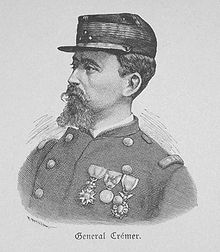Skirmish at Nuits
Franco-German War (1870–1871)
Weißenburg - Spichern - Wörth - Colombey - Strasbourg - Toul - Mars-la-Tour - Gravelotte - Metz - Beaumont - Noisseville - Sedan - Sceaux - Chevilly - Bellevue - Artenay - Châtillon - Châteaudun - Le Bourget - Coulmiers - Battle of Havana - Amiens - Beaune-la-Rolande - Villepion - Loigny and Poupry - Orléans - Villiers - Beaugency - Nuits - Hallue - Bapaume - Villersexel - Le Mans - Lisaine - Saint-Quentin - Buzenval - Paris - Belfort
The battle of Nuits (French Bataille de Nuits-Saint-Georges ) on December 18, 1870, was a meeting of the Franco-German War , in which units of the Baden field division under General von Glümer , who attacked in the area south of Dijon , inflicted a defeat on an almost equally strong French division under Camille Crémer .
prehistory
The siege of Belfort began on November 26th by the German 1st Reserve Division. The Baden field division had advanced as far as Dijon, which was conquered on October 31, 1870 after brief fighting. In the middle of December the thaw set in; The French used this circumstance for active activity in the area south of Dijon. On December 14th, the French general Crémer occupied the small town of Nuits . General von Werder , the commander of the Badeners, noticed the danger that threatened Dijon and immediately reacted with countermeasures. To protect the city, the 3rd Brigade from Baden stayed behind in Dijon. General Gluemer received the order to bring the 1st and 2nd Brigade (12 battalions , 7 squadrons and 6 batteries ) with about 10,500 men and 36 artillery towards the enemy. The strength of the French Crémers division, which was established between Nuits and Beaune , was initially unknown to the German leadership. Later, however, two brigades were identified, which together numbered 12,800 men with 20 guns. Crémer's left flank on the Saone was secured by General Pelissier with mobile and national guards, who also controlled the river crossings at Verdun and Seurre. On the left wing of Crémer on the heights of Autun , the Italian volunteer corps was still under Garibaldi .
course
The Badeners met the French outposts, which went back to Gevrey and from the forests on the Vougebach in the east of Boncourt le Bois on Beaune, where they caught up with the French bulk. The Baden Brigade von Degenfeld was involved in a heavy battle on the left wing on the heights , which extended to the whole line. Around noon, the Baden avant-garde first encountered resistance at Boncourt, stormed this suburb on the right and took Agencourt on the left. The French main battle line had been established along the railway and the Menzinbach. Around 2 p.m. General Gluemer ordered a general attack. After the Germans had also snatched La Berere from their opponents, they led the 1st and 2nd Battalions of the Baden Leib-Grenadier-Regiment under Colonel von Wechmar against the railway line and the station of the town, where the decision of the day was made fell. The 1st Battalion suffered heavy losses through the French Chassepots when Agencourt pushed against the embankment and the railway cut there . Before things got critical, fresh battalions of the 2nd Grenadier Regiment arrived with four heavy batteries. With adequate fire protection, Prince Wilhelm's entire brigade advanced against the railway line, and the attack by the fusiliers of the 2nd regiment was particularly effective.
The French began to give way, only in the north of the station they continued to offer strong resistance. French batteries, which operated from the dominant height of Chaux, tore large gaps in the Baden lines of attack. Both General Glümer and Prince Wilhelm were seriously wounded and had to leave the battle. After the prince's departure, Colonel von Renz took over the leadership of the brigade, but fell a little later at the side of his adjutant due to French rapid fire. At this time, however, the left wing of the Baden team was already achieving decisive success. Two battalions of the Degenfeld Brigade had taken Vosnes and Conceux and rolled up the French position from the other flank. Around 5 p.m., Nuits fell into the hands of the Baden people, who had lost almost 940 men to the dead and wounded. The French lost 1,700 men in this meeting, 650 of whom fell into German captivity without being wounded.
consequences
After Glümers was wounded, General Werder himself took over command of the battle. On the morning of December 19, the withdrawal of the French was determined, the forces of the XIV Army Corps were insufficient for a pursuit. Finally, seven battalions had to be surrendered to the Belfort containment ring . General Werder went back to Dijon, where the rest of the month ended without fighting. The French Eastern Army was now concentrated and strengthened in the Besançon area. This caused the Germans to give up Dijon on December 27th. At the meeting near Villersexel on January 9, 1871, the French achieved a tactical success that the German XIV Army Corps reversed by winning the Battle of the Lisaine .
literature
- Hermann Kunz: The battle at Nuits on December 18, 1870. ES Mittler and son, Berlin 1892.
- Theodor Fontane: The war against France 1870–1871. Complete edition in 2 volumes, Rockstuhl Verlag, Bad Langensalza 1873.
- Georg Hiltl: The French War of 1870 and 1871. Verlag von Belhagen and Klasing, Bielefeld and Leipzig 1892, p. 729.


